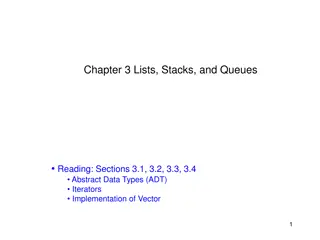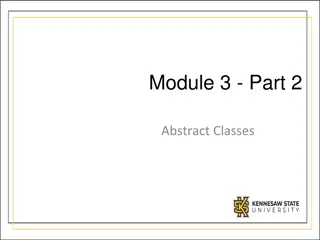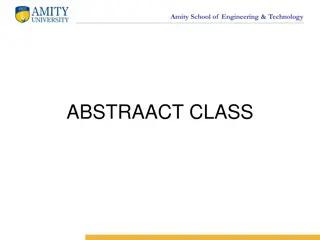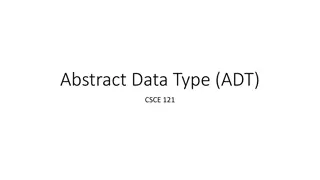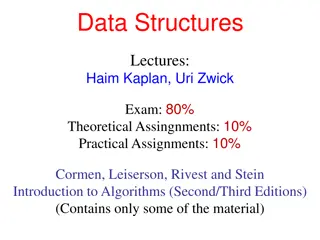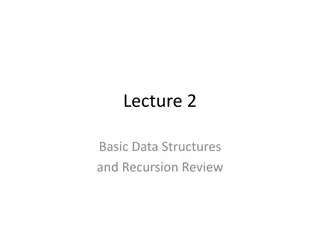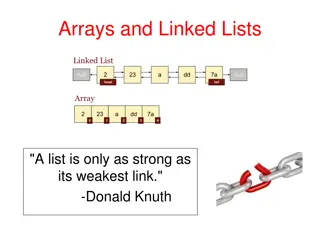Understanding Abstract Data Types: Lists Exploration
Explore the concept of list abstract data types, different classes of lists, and various list implementations including ordered, unordered, and indexed lists. Understand how elements are organized in ordered lists based on characteristics, how unordered lists allow flexibility in element placement, and how indexed lists reference elements by position. Delve into visual representations and conceptual views of these list types.
Download Presentation

Please find below an Image/Link to download the presentation.
The content on the website is provided AS IS for your information and personal use only. It may not be sold, licensed, or shared on other websites without obtaining consent from the author. Download presentation by click this link. If you encounter any issues during the download, it is possible that the publisher has removed the file from their server.
E N D
Presentation Transcript
Objectives Define a list abstract data type Examine different classes of lists Examine various list implementations Compare list implementations 9-2
Lists A listis a linear collection, like a stack and queue, but more flexible: adding and removing elements from a list does not have to happen at one end or the other We will examine three types of list collections: ordered lists unordered lists indexed lists 9-3
Ordered Lists Ordered list: Its elements are ordered by some inherent characteristic of the elements Examples: Names in alphabetical order Numeric scores in ascending order So, the elements themselves determine where they are stored in the list 9-4
Conceptual View of an Ordered List rear front 16 23 29 40 51 67 88 New values must be inserted so that the ordering of the list is maintained 58 9-5
Unordered Lists Unordered list: the order of the elements in the list is not based on a characteristic of the elements, but is determined by the programmer A new element can be put at the front of the list, at the rear of the list, or after a particular element already in the list 9-6
Conceptual View of an Unordered List rear front New values can be inserted anywhere in the list 9-7
Indexed Lists Indexed list: elements are referenced by their numeric positionin the list, called its index It is the position in the list that is important, and the programmer can determine the order in which the items go in the list Every time the list changes, the position (index) of an element may change 9-8
Conceptual View of an Indexed List rear front 1 2 3 4 5 6 7 index New values can be inserted at any position in the list 9-9
List Operations Operations common to all list types include: Adding/removing elements Checking the status of the list (isEmpty, size) Iterating through the elements in the list The key differences between the list types involve the way elements are added 9-10
Operations on the List ADT Operation Description removeFirst removeLast remove(element) Removes the first element from the list Removes the last element from the list Removes a particular element from the list first last contains(element) isEmpty size toString Gets the element at the front of the list Gets the element at the rear of the list Determines if a particular element is in the list Determines whether the list is empty Determines the number of elements in the list Returns a string representation of the list 9-11
Operation Particular to an Ordered List Operation Description add Adds an element to the list (in the correct place) 9-12
Operations Particular to an Unordered List Operation Description addToFront addToRear addAfter Adds an element to the front of the list Adds an element to the rear of the list Adds an element after a particular element already in the list 9-13
Operations Particular to an Indexed List Operation Description add Adds an element at a particular index in the list set Sets the element at a particular index in the list overwriting any element that was there get Returns a reference to the element at the specified index indexOf Returns the index of the specified element remove Removes and returns the element at a particular index 9-14
List Operations We use Java interfaces to formally define the lists ADTs Note that interfaces can be defined via inheritance (derived from other interfaces) Define the common list operations in one interface See ListADT.java Derive the thee others from it see OrderedListADT.java see UnorderedListADT.java see IndexedListADT.java 9-15
ListADT Interface public interface ListADT<T> { // Removes and returns the first element from this list public T removeFirst ( ); // Removes and returns the last element from this list public T removeLast ( ); // Removes and returns the specified element from this list public T remove (T element); // Returns a reference to the first element on this list public T first ( ); // Returns a reference to the last element on this list public T last ( ); // cont d.. 9-16
// ..contd // Returns true if this list contains the specified target element public boolean contains (T target); // Returns true if this list contains no elements public boolean isEmpty( ); // Returns the number of elements in this list public int size( ); // Returns a string representation of this list public String toString( ); } 9-17
OrderedList ADT public interface OrderedListADT<T> extends ListADT<T> { // Adds the specified element to this list at the proper location public void add (T element); } 9-18
UnorderedListADT public interface UnorderedListADT<T> extends ListADT<T> { // Adds the specified element to the front of this list public void addToFront (T element); // Adds the specified element to the rear of this list public void addToRear (T element); // Adds the specified element after the specified target public void addAfter (T element, T target); } 9-19
IndexedListADT public interface IndexedListADT<T> extends ListADT<T> { // Inserts the specified element at the specified index public void add (int index, T element); // Sets the element at the specified index public void set (int index, T element); // Returns a reference to the element at the specified index public T get (int index); // Returns the index of the specified element public int indexOf (T element); // Removes and returns the element at the specified index public T remove (int index); } 9-20
Discussion Note that the remove method in the IndexedList ADT is overloaded Why? Because there is a remove method in the parent ListADT This is not overriding, because the parameters are different 9-21
List Implementation using Arrays Container is an array Fix one end of the list at index 0 and shift as needed when an element is added or removed Is a shift needed when an element is added at the front? somewhere in the middle? at the end? Is a shift needed when an element is removed from the front? from somewhere in the middle? from the end? 9-22
An Array Implementation of a List An array-based list ls with 4 elements 0 1 2 3 4 5 ? ? ? list ls 4 rear 9-23
//-----------------------------------------------------------------//----------------------------------------------------------------- // Removes and returns the specified element. //----------------------------------------------------------------- public T remove (T element) throws ElementNotFoundException { T result; int index = find (element); // uses helper method find if (index == NOT_FOUND) throw new ElementNotFoundException("list"); result = list[index]; rear--; // shift the appropriate elements for (int scan=index; scan < rear; scan++) list[scan] = list[scan+1]; list[rear] = null; return result; } 9-24
//-----------------------------------------------------------------//----------------------------------------------------------------- // Returns the array index of the specified element, // or the constant NOT_FOUND if it is not found. //----------------------------------------------------------------- private int find (T target) { int scan = 0, result = NOT_FOUND; boolean found = false; if (! isEmpty( )) while (! found && scan < rear) if (target.equals(list[scan]) found = true; else scan++; if (found) result = scan; return result; } 9-25
//-----------------------------------------------------------------//----------------------------------------------------------------- // Returns true if this list contains the specified element. //----------------------------------------------------------------- public boolean contains (T target) { return (find(target) != NOT_FOUND); //uses helper method find } 9-26
The Comparable Interface For an ordered list, the actual class for the generic type Tmust have a way of comparing elements so that they can be ordered So, it must implement the Comparable interface, i.e. it must define a method called compareTo But, the compiler does not know whether or not the class that we use to fill in the generic type T will have a compareTo method 9-27
The Comparable Interface So, to make the compiler happy: Declare a variable that is of type Comparable<T> Convert the variable of type T to the variable of type Comparable<T> Comparable<T> temp = (Comparable<T>)element; Note that an object of a class that implements Comparable can be referenced by a variable of type Comparable<T> 9-28
//-----------------------------------------------------------------//----------------------------------------------------------------- // Adds the specified Comparable element to the list, // keeping the elements in sorted order. //----------------------------------------------------------------- public void add (T element) { if (size( ) == list.length) expandCapacity( ); Comparable<T> temp = (Comparable<T>)element; int scan = 0; while (scan < rear && temp.compareTo(list[scan]) > 0) scan++; for (int scan2=rear; scan2 > scan; scan2--) list[scan2] = list[scan2-1] list[scan] = element; rear++; } 9-29
List Implementation Using Arrays, Method 2: Circular Arrays Recall circular array implementation of queues Exercise: implement list operations using a circular array implementation 9-30
List Implementation Using Links We can implement a list collection with a linked list as the container Implementationuses techniques similar to ones we've used for stacks and queues We will first examine the removeoperation for a singly-linked list implementation Then we ll look at the removeoperation for a a doubly-linked list, for comparison 9-31
//-----------------------------------------------------------------//----------------------------------------------------------------- // Removes the first instance of the specified element // from the list, if it is found in the list, and returns a // reference to it. Throws an ElementNotFoundException // if the specified element is not found on the list. //----------------------------------------------------------------- public T remove (T targetElement) throws ElementNotFoundException { if (isEmpty( )) throw new ElementNotFoundException ("List"); boolean found = false; LinearNode<T> previous = null LinearNode<T> current = front; // cont d.. 9-32
while (current != null && !found) if (targetElement.equals (current.getElement( ))) found = true; else { previous = current; current = current.getNext( ); } if (!found) throw new ElementNotFoundException ( No data"); if (size( ) == 1) front = rear = null; else if (current.equals (front)) front = current.getNext( ); else // cont d 9-33
if (current.equals (rear)) { rear = previous; rear.setNext(null); } else previous.setNext(current.getNext( )); count--; return current.getElement( ); } 9-34
Doubly Linked Lists A doubly linked list has two references in each node: One to the next element in the list One to the previous element This makes moving back and forth in a list easier, and eliminates the need for a previous reference in particular algorithms Disadvantage? a bit more overhead when managing the list 9-35
Implementation of a Doubly- Linked List A doubly-linked list dl with 4 elements . . rear dl front 4 count 9-36
See DoubleNode.java We can then implement the ListADT using a doubly linked list as the container Following our usual convention, this would be called DoublyLinkedList.java 9-37
public DoubleNode<T> find (T element) { DoubleNode<T> current = front; while (current != null && !element.equals(current.getElement())) current = current.getNext(); return current; } 9-38
public T remove (T element) throws ElementNotFoundException { DoubleNode<T> node = find (element); if (node == null) throw new ElementNotFoundException ( No element"); if (node == front) front = node.getNext(); else (node.getPrevious()).setNext(node.getNext()); if (node == rear) rear = node.getPrevious(); else (node.getNext()).setPrevious(node.getPrevious()); count--; return node.getElement(); } 9-39
// Adds element to the list, keeping the list sorted. public void add (T element) { Comparable<T> temp = (Comparable<T>)element; DoubleNode<T> newNode = new DoubleNode<T>(element); If (front == null) { front = newNode; rear = newNode; } else { DoubleNode<T> current = front; while (current != null && temp.compareTo(current.getElement() > 0) current = current.getNext(); if (current == null) { // Add newNode at the end of the list rear.setNext(newNode); newNode.setPrev(rear); rear = newNode; } 9-40
else { // newNode is not added to the end newNode.setNext(current); newNode.setPrev(current.getPrev()); current.setPrev(newNode); if (newNode.getPrev() != null) newNode.getPrev().setNext(newNode); else front = newNode; } ++count; } 9-41


